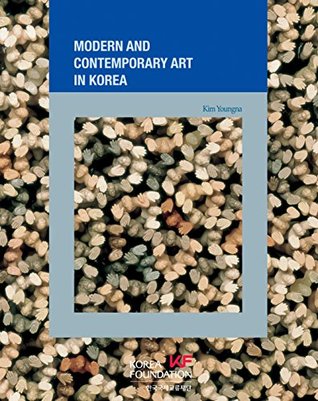Kindle Notes & Highlights
by
Youngna Kim
Read between
July 12 - July 12, 2019
Website: http://www.kf.or.kr
Hollym has printed some of the pictures in this book without permission of the artist, owner, or organization that owns the rights to them because we were unable to locate said party. If any of the pictures happen to be yours, please contact us at once and you will be fully reimbursed for the use of the picture(s).
Website: http://www.hollym.co.kr
Though the tradition of ink paintings lives on in Korean modern art, tradition itself does not reside solely in the materials used. Because tradition appears newly interpreted in oils, acrylics, and now mainstream works like photography, installation art, and video, distinguishing between materials in the name of tradition has little meaning.
interpretation of tradition can vary according to era and societal change, and because new elements can be added, national identity is fluid rather than fixed.
As Western culture flooded into the region, it engendered discord with traditional cultures, thus ushering in the modern era and a sea change. Korea was no exception to this phenomenon.
The Joseon government, which could not grasp the extreme change being brought by Western society, vacillated in the power struggle between the conservative and reform parties, but from the 1880s it began to turn toward accepting Western culture, which was called “New Culture” at the time. By then it was already difficult to maneuver in the contest of vested rights between the great powers of the West and the rest of Northeast Asia. Finally, Korea was made a protectorate of Japan in 1905 and was annexed in 1910.
Japan posed as the intermediary for bringing modernization and “New Culture” to Korea, but only to the extent that Japan as colonizer profited. Therefore, during the Japanese occupation, Korea’s modernization took on the unique characteristics of modernization within the context of colonialism.
Modernity is a concept that originally sprang from the West. It was indicative of human experience in 19th century Europe, the age of industrialization.
Certain national and social systems became standardized, and modern scholarship was approached through science and positivism.
Though it was via Japan, Korea’s modernization began, together with its shocks, as Western modern concepts were slowly transplanted into the lives of Koreans.
Artists of the new generation perceived both Monochrome and Minjung art as movements that converge on uniformity.
They discovered more heterogeneity in their own traditions than in Western culture.
This book deals with the issues of tradition, modernity, and identity in modern and contemporary art in Korea.
Ko Hui-dong’s (1886-1965) Laundry at a Clear Stream (fig. 1) is an intriguing painting. Ko, Korea’s first artist to study Western-style painting, who graduated from the Tokyo School of Fine Arts and returned to Korea in 1915,
First there is the plebeian theme of an ordinary couple’s daily life,
especially as the man’s skin is partially exposed.
Finally, there is the use of Western perspective, such that the foreground, middle ground, and...
This highlight has been truncated due to consecutive passage length restrictions.
1915, Ink on silk, 23 x 27.5 cm, Kansong Art Museum
emissaries
Hubert Vos (1885-1935), an American painter who emigrated from the Netherlands, painted the portraits of Emperor Gojong and several officials as well as Seoul landscapes (fig. 2) during his Asian journey. However, the popularization of oil paintings came about through early pioneers like Ko Hui-dong, who after returning from study in Tokyo joined group activities or taught art classes to students. fig. 2) Hubert Vos, Landscape of Seoul, 1899, Oil on canvas, 30 x 60 cm, National Museum of Contemporary
Art
Here I will examine Ko in more detail, not only because he was the first Western-style painter from Korea, but also because his developmental process,
Remion had been invited to establish a craft arts school in Korea, but this plan was not materialized, and after a few years, Remion returned to France.
frustrated when the Protectorate Treaty was signed between Korea and Japan the following year.
the shame of annexation.
Having seen Remion’s Western-style paintings early on, he was curious about Western art, and in 1909 he entered Japan’s state art school, the Tokyo School of Fine Arts.
art exhibits were incorporated into this fair, and two of Ko’s works displayed were Woman Playing a Gayageum (zither) and A Woman.
in 1918 Ko founded an art group called the Society of Painters and Calligraphers (Seohwa Hyeophoe),
fig. 4) Na Hye-seok, Peony at Hwa-ryeong Pavilion, 1923, Oil on wood, 34 x 23 cm, Ho-am Art Museum
He represents himself as a scholar rather than an artist. Most early modern artists, including Ko, came from wealthy homes.
fig. 5) Ko Hui-dong, Self-portrait, 1915, Oil on canvas, 61 x 46 cm, National Museum of Contemporary Art
he was keenly interested in the Renaissance and Baroque periods.
Yi Kwae-dae, Self-portrait, 1940s, Oil on canvas, 72 x 60 cm, Private collection
Chang Woo-soung, Studio, 1943, Color on paper, 215 x 171 cm, Ho-am Art Museum
a woman stands in a garden where wildflowers bloom and the branches of a willow tree flutter.
10) Kim Ki-chang, Listening, 1934, Color on silk, 193 x 130 cm, Private collection [Courtesy of Woonbo Foundation of Culture]
Fauvism.
annexation,


